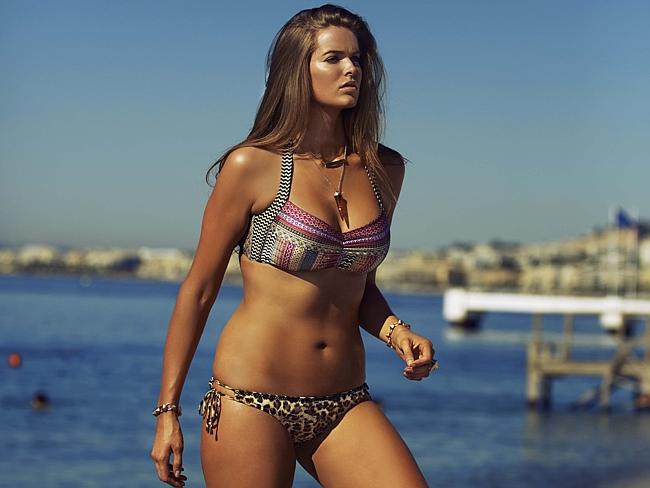Cosmopolitan Magazine’s December 2013 issue published the new swimwear collection featuring Robyn Lawley, a 6’2″ model deemed by Cosmo as “plus-size”
Plus-size Label Contradicts Cosmo’s Objective of Female Empowerment
“Plus” is a mathematical indicator for addition, or a reference to a deviation greater than the standard. However, when it comes to female models, the fashion industry has reserved this label for attractive women who are anything more than pencil thin. By pointedly referring to tall, slender and seemingly flawless Robyn Lawley as “plus size,” Cosmopolitan magazine strays from its original mission to empower women by perpetuating unrealistic ideals for women’s body norms.
Cosmo was founded in the 1960s with its objective being to break down — and emancipate women from — the traditional molds of patriarchal society. However, by needlessly labeling anything or anyone above a size eight as “plus size,” the magazine creates its own extremely challenging and unrealistic standard for “normal” body sizes. In reality, a “plus” size in the modeling world is much leaner than the average American female. At six foot two, Lawley’s size 12 is still smaller than the typical American dress size of 14.
According to the National Eating Disorders Association, some 20 million women across the U.S. suffer from an eating disorder at some point in their lives. Many of these women are young, fit and not overweight. This number is a strong indicator of the high priority women place on achieving the ever-shrinking “average” body size. In an interview with Ellen Degeneres, alleged “plus-sized” Lawley states that she has learned to love her body by focusing only on the way she sees herself. Perhaps if the fashion industry stopped being obsessed with labeling women by their body types, these women could stop measuring their self-worth by the same.
— Mikayla Murry
Staff Writer
Ordinary Women Should Not Gauge Beauty According to Model Standards
Model Robyn Lawley stands tall at 6’2”, and is proportionately built to her height at a size 12. Lawley is healthy, but she is still four sizes above the norms of modeling. In the fashion industry, this makes her body type considered plus-sized. Clearly this is a stark difference from our own perception, but a model is held to elevated standards that the ordinary woman should not compare herself against.
In America, half of women wear a size 14 or larger, with the average woman weighing in at 164.7 pounds. According to PLUS Model magazine, the average fashion model weighs in at 23 percent less than the average woman. That is a sizable difference, but the priorities of the fashion world have to be taken into account. The fashion industry holds women to completely different standards: Anyone over a size 8 is considered plus-sized. This is because, first and foremost, fashion is art. Making clothes look fantastic involves using women who are at the extreme end of the beauty spectrum, representing something that is not meant to be normal in the slightest. Models are simply not meant to be thought of as average, and ordinary women should not hold themselves to the same lofty standards. Even Lawley herself clarifies that she is a plus-size model, not a plus-size woman.
While the fashion industry promotes arguably unrealistic portrayals of women, their actions must be taken with a grain of salt. Lawley is healthy, but she is deemed a plus size. To call her that in other circumstances is a different matter. But people should remember that the realm of fashion is a world of its own, with unique expectations and ideals.
— Charu Mehra
Staff Writer
Plus-size Models Inspire Women and Redefine Perceptions of Beauty
It is now common to hear of supermodel horror stories: Eating disorders and airbrushed curvy young girls down to size one are plastered on the glossy pages of magazines. The increasing prominence and popularity of “plus-size” models strengthens this new awareness that sizes 0, 2 and 4 are unhealthy if unnaturally reached. Cosmopolitan Magazine’s use of models like Robyn Lawley ultimately addresses the underlying causes of health issues like anorexia, rather than promoting the same size 0 Victoria’s Secret-like models’ body images.
In 2006, the National Association of Anorexia Nervosa and Associated Disorders confirmed that 47 percent of girls in 5th to 12th grade reported wanting to lose weight because of magazine pictures, ultimately showing the heavy impact media outlets have in shaping body image. Cosmo is in a unique position to start positive change.
In the January 2014 online issue of Cosmopolitan magazine, editor Laura Beck explained that many “’plus-size’ models are [both] beautiful and healthy.” Using models like Lawley shows Cosmo’s support for women who visibly disagree with the “thin ideal.” Lawley herself directly addresses the dangerous “thigh-gap trend,” explaining that she and many others have the power “to change perceptions about body image.” Lawley explicitly redefines her role as a model in the fashion industry from simply a “clothes hanger” to one who gets “to travel the world advancing the ideal that healthy is beautiful.”
Cosmo’s new relationship with models like Lawley shows that the fashion industry is one step closer to redefining beauty by promoting women who are healthy instead of simply thin.
— Alia Bales
Staff Writer









babs bunny • Sep 12, 2023 at 2:22 pm
You sell this story as a positive, but we’re still looking at a completely normal, maybe even skinny woman, who is being called “plus sized”.
Throw away the entire industry.